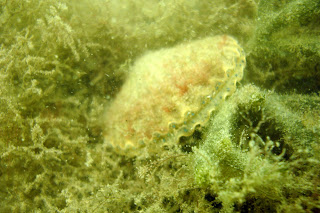
Well, this week was a big week of sampling for me...

Not only was my first field sampling for the scallop growth experiment in the grass mats, I also planned to use this week as a scallop predation experiment week... The scallops for growth were measured two weeks ago, transported to the site, placed into white spat bags, and set at locations in my artificial seagrass array...

I was pretty excited going forward with the growth experiment because it worked out so well last year, and I almost doubled the number of scallops this year that I used last year... So you could expect why I was looking forward to this week, T-2 weeks, to see how my scallops were doing...

DISAPPOINTMENT!!! I would have to say using back of the envelop calculations, approximately 30% of my scallops did not survive to this sampling period! This was particularly shocking to me, since I only lost about 10% of the scallops I used last summer during the entire 12 week growth experiment... Of course, I was bummed... We measured the dead ones anyway, hoping that after I come up with a growth rate at the end of the experiment, I could approximate when they might have died... However, quickly looking at the numbers indicated to me that most of them probably died the day they were put out in the field... I suspect this is more likely the case, and I blame myself for this... There were probably some issues in transporting the juveniles from the hatchery facility to the field site, and then the time it took to get all of them into bags and situated onto their respective sites, they were probably out of water too long... This wasn't such a problem last year, but again, with almost twice as many scallops to place out in the field, almost twice the amount of time is needed to actually put them all out... So, suffice it to say I will be putting out some more scallops the next sampling to make up for the loss...

The second experiment worked out much better this time... Last year I tried this same predation experiment with no success - problems recovering tethers, loss of scallops during transport, tether tangling, screwy and missing data points... So I tinkered with and refined my methods for this year, and WOW!!!

Things worked out so much better this time around... Predation was as expected and I actually pseudo-observed a scallop being preyed upon...


After putting out all my tethers on Tuesday, 8/19, I went back with my camera to get some pictures, and when I went to the unvegetated tethers, I noticed a fishing line going into a half clam shell... I thought it was weird that the scallop would swim into there and byss, so I tried to pull the line, but it wouldn't budge... Upon further inspection, I saw a mud crab under the shell with the scallop shell, now in two halves... I tried to get a picture...

Anyway, this was exciting that it happened so quickly (if I had to guess, I would say within an hour and a half after release)... And I am very pleased with my results this time around... There are still some bugs to work out, namely preventing scallop tethers from tangling with each other during transport, but I look forward to running this experiment again in the fall...
Additionally exciting is that I observed adult scallops in or near my mats again this time!!!

And, a fellow diver, Andrew, observed some small scallop spat (probably in the 7-10mm range) on my mats, and if you remember from previous posts, I have been very disappointed for the lack of scallop recruits to my mats, so this was very good and welcoming news, and so this means that my recruitment experiment is starting to look up!!!
I also saw many fish again this time - including
weakfish (probably about the size of the one in the photo from the web) for the first time, juveniles of course, and the usual suspects of pipefish, sticklebacks, tautog and cunner, and possibly a black sea bass, but visibility wasn't great and whatever it was swam away very quickly... Oh, and I saw this big spider crab who tried to get me!!!

By the by, check out Chris Pickerell of Seagrass.LI's blog
here... He's got some pretty exciting stories going on, including pregnant seahorses, and horny (read:territorial) male sea robins...
Oh and stay tuned for slide shows from this week...






 Some of the scallops are pretty fouled (the latter two were collected a day earlier),
Some of the scallops are pretty fouled (the latter two were collected a day earlier), 





















































